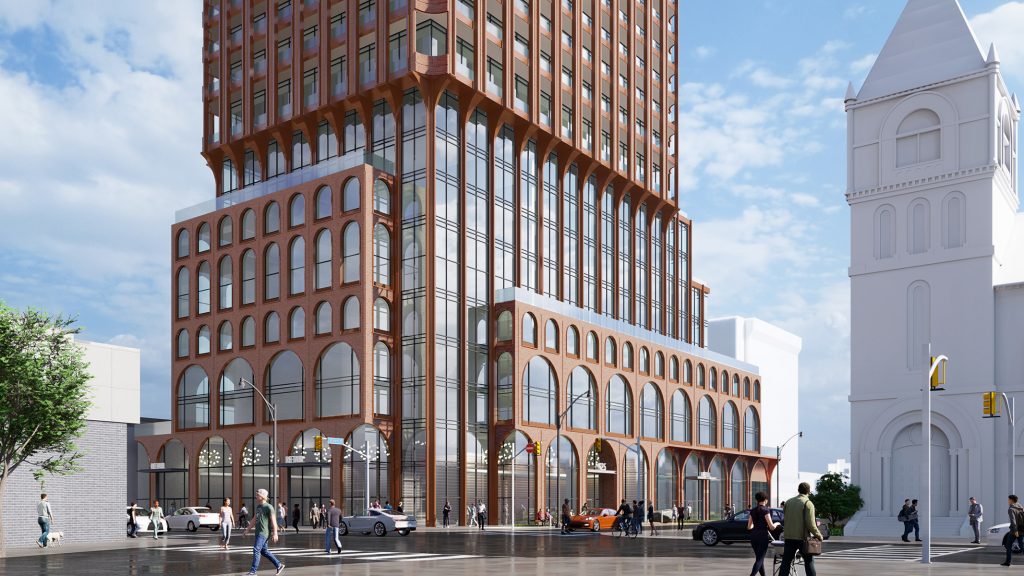Grocer to relocate to the northwest corner of Bloor and Spadina

COURTESY PETER VENETAS, BOUSFIELDS INC.
By Fox Oliver
On Oct. 12, 2022, Bousfields Inc. submitted an application to build a 30-storey tower at 425 Bloor St. W.
The mixed-use building is designed to make the most out of land in a high-traffic area which currently hosts a single-storey Metro grocery store.
The building, designed by the IBI Group, would feature a six-storey “podium design,” topped with a 24-storey residential tower. The 418 residential units in the building would likely be condominium units, consisting of 79 studios, 229 single-bedroom units, 67 two-bedroom units, and 43 three-bedroom units.
Over 1000 square metres of space on the ground and mezzanine floors would be used for retail purposes.
The proposed tower would replace the Metro at 425 Bloor St. W. and Robert Street that many nearby residents depend on; however, Stephanie Bonk, communications manager at Metro, confirmed that Metro will not be leaving the community.
It will be relocating to an upcoming 35-storey mixed-use building at 350 Bloor St. W. which is being developed by the same team as the 425 Bloor St. W. building.
“The current (Metro) location will not move until the new store is built, so no store closure will be required,” added Bonk.
The development at 425 Bloor St. W. cannot begin construction until site plan approval is administered by the city and the building at 350 Bloor St. W. is complete.
Construction at 350 Bloor St. W. is estimated to last 36 months once it begins, meaning the project at 425 Bloor St. W. will not begin for a minimum of three years. Construction at 425 Bloor St. W. would also take approximately 36 months to complete, if planning goes as expected.
“We’re trying to create a highly animated public realm,” said Peter Venetas, project manager for both the 350 and 425 Bloor St. W. developments.
This involves expanding the sidewalk on Bloor Street to a width of 6 metres, creating active retail space, and expanding upon the work that the Bloor-Annex BIA has done along the Robert St. parkette.
Enhancement of the public realm is particularly important as the building lies within 500 metres of a subway node and is likely to generate increased pedestrian traffic in the area.
The brickwork, archways, and large windows incorporated in the building’s facade are inspired by its surroundings and designed to compliment visual themes in the Annex.
The building will incorporate multiple green roofs totalling at least 60 per cent of available roof space as required by Chapter 492 of the Toronto Municipal Code.
“It is too early to say for certain how the building will affect the area,” said Sue Dexter, a founding board member of the Harbord Village Residents’ Association (HVRA).
Dexter says that it is especially important for the developers to listen to the community while planning, as the building would exist on both the commercial Bloor Street West and the residential Robert Street.
“We (the HVRA) will be engaged in a lot of discussion with the developers throughout the process,” said Dexter.
The likelihood of increased pedestrian and vehicular traffic, the developers’ ability to tap into the University of Toronto’s geothermal project under the adjacent Robert St. Field, and opportunities to engage with the abutting parkette will all be points of conversation for the HVRA and the developers, elaborated Dexter.
Participating in dialogue with the community is not a new initiative for the developers.
“We’ve learned a lot of things from our work at 350 Bloor. We’ve been engaging in community discussion since 2018, and we will continue to learn from our surroundings,” said Venetas.
Currently the development team is planning to engage with a handful of community stakeholders, including the city councillor’s office, the HVRA, the Annex Residents’ Association, the Bloor-Annex BIA, Trinity-St. Paul’s Church, and the Miles Nadal Jewish Community Centre.
Venetas said that a formal engagement process will also take place with these groups once the application process reaches a later stage.
Venetas invites residents to read more about the development projects on their community consultation websites which can also be used to share comments with the development team.
